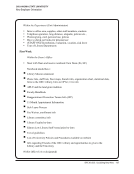Introduction
to
National
Archives
and
Records
Administration
Module
5 Page
2
Course
Summary Congratulations!
You
have
completed
the
Introduction
to
NARA
course.
It's
time
to
review
some
key
points
from
this
course. Module
One--
of
NARA
covered
the
following
key
points:
•
NARA
was
formed
because
records
were
widely
dispersed
and
in
jeopardy,
and
various
organizations
requested
a
single
agency
be
charged
with
maintaining
the
Government's
historical
records.
•
NARA
is
an
independent
agency
of
the
executive
branch
of
the
federal
government.
In
our
facilities
around
the
country,
customers
are
able
to
discover,
use,
and
learn
from
this
history.
•
NARA
is
an
important
part
of
the
Federal
Government
and
continues
to
grow
and
embrace
its
mission
of
safeguarding
and
preserving
the
records
of
our
Government.
•
We
wicontinue
ll
to
ensure
that
American
citizens
have
access
to
records
that
document
the
actions
of
their
Government
and
promote
the
historical
understanding
of
our
national
experience.
•
The
mission
of
NARA
is
rooted
in
various
laws
that
provide
NARA
with
its
authority.
Module
Two--
and
Organization
covered
the
following
key
points:
•
All
employees
and
program
offices
throughout
the
country
are
connected
and
are
vital
parts
of
NARA.
•
NARA
has
eight
staff
offices
and
six
program
offices.
Each
of
these
offices
has
specific
functions.
Module
Three--Managing
our
Government's
Information,
covered
the
following
key
points:
•
The
records
life
cycle
includes
the
following
steps:
Records
Creation,
Records
Maintenance,
Records
Disposition,
Archival
Preservation,
and
Access.
•
At
NARA,
our
work
touches
all
stages
of
the
records
life
cycle.
The
Federal
Register,
Information
Security
Oversight
Office,
Presidential
Libraries,
Office
of
Records
Services,
Washington,
DC,
and
Office
of
Regional
Records
Services
all
play
a
key
role.
•
The
offices
of
Records
Services,
Washington,
DC,
and
Regional
Records
Services
collaborate
in
implementing
a
National
Records
Management
Program
intended
to
assist
agencies.
•
An
important
outcome
of
successful
Federal
records
management
is
the
identification
of
records
appropriate
for
transfer
to
the
custody
of
the
Archivist
for
long
term
preservation
and
access.
•
NARA's
holdings
provide
information
about
people,
places,
and
events.
SPEC Kit 323: Socializing New Hires · 77
National Archives and Records Administration
Introduction to National Archives and Records Administration, Module 5: Course Summary
to
National
Archives
and
Records
Administration
Module
5 Page
2
Course
Summary Congratulations!
You
have
completed
the
Introduction
to
NARA
course.
It's
time
to
review
some
key
points
from
this
course. Module
One--
of
NARA
covered
the
following
key
points:
•
NARA
was
formed
because
records
were
widely
dispersed
and
in
jeopardy,
and
various
organizations
requested
a
single
agency
be
charged
with
maintaining
the
Government's
historical
records.
•
NARA
is
an
independent
agency
of
the
executive
branch
of
the
federal
government.
In
our
facilities
around
the
country,
customers
are
able
to
discover,
use,
and
learn
from
this
history.
•
NARA
is
an
important
part
of
the
Federal
Government
and
continues
to
grow
and
embrace
its
mission
of
safeguarding
and
preserving
the
records
of
our
Government.
•
We
wicontinue
ll
to
ensure
that
American
citizens
have
access
to
records
that
document
the
actions
of
their
Government
and
promote
the
historical
understanding
of
our
national
experience.
•
The
mission
of
NARA
is
rooted
in
various
laws
that
provide
NARA
with
its
authority.
Module
Two--
and
Organization
covered
the
following
key
points:
•
All
employees
and
program
offices
throughout
the
country
are
connected
and
are
vital
parts
of
NARA.
•
NARA
has
eight
staff
offices
and
six
program
offices.
Each
of
these
offices
has
specific
functions.
Module
Three--Managing
our
Government's
Information,
covered
the
following
key
points:
•
The
records
life
cycle
includes
the
following
steps:
Records
Creation,
Records
Maintenance,
Records
Disposition,
Archival
Preservation,
and
Access.
•
At
NARA,
our
work
touches
all
stages
of
the
records
life
cycle.
The
Federal
Register,
Information
Security
Oversight
Office,
Presidential
Libraries,
Office
of
Records
Services,
Washington,
DC,
and
Office
of
Regional
Records
Services
all
play
a
key
role.
•
The
offices
of
Records
Services,
Washington,
DC,
and
Regional
Records
Services
collaborate
in
implementing
a
National
Records
Management
Program
intended
to
assist
agencies.
•
An
important
outcome
of
successful
Federal
records
management
is
the
identification
of
records
appropriate
for
transfer
to
the
custody
of
the
Archivist
for
long
term
preservation
and
access.
•
NARA's
holdings
provide
information
about
people,
places,
and
events.
SPEC Kit 323: Socializing New Hires · 77
National Archives and Records Administration
Introduction to National Archives and Records Administration, Module 5: Course Summary






























































































































































